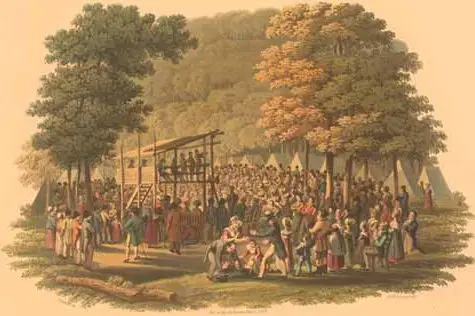The Second Great Awakening
The Second Great Awakening in the United States took place from the later decade of the 18th century into the middle of the 19th century.
Many different religions participated in the religious movement. The Second Great Awakening changed the religious outlook of the United States. The religious movement also changed how people worshipped, thought about themselves, and god.
The Second Great Awakening helped form new political alliances within the United States and political movements.
The beginning
When the United States gained their freedom from England, the religions in the United States were mainly Congregationalists, Anglicans, Quakers, and Presbyterians. These religions found an early home in the United States.
The religious groups had been noticed by the Founding Fathers. The Founding Fathers were afraid of mingling religion with politics. They included protections in the First Amendment to establish a separation between church and state to help resolve this problem.

With the separation of church and state there was a series of religious revivals that started to evolve around the United States. These religious revivals were the foundation for the Second Great Awakening in the United States. The Second Great Awakening changed the religious landscape in the United States for years to come in the future.
The movement
The Second Great Awakening started in upstate New York around 1800. The movement spread across new frontiers being established in places like Kentucky, Tennessee, and Ohio.
The movement is best described as large outdoor religious meetings. As the country began to move west while opening new lands for settlers, the typical church was not found. Settlers generally lived far apart from each other.
Thus the old fashion idea of going to church was not available to most new settlers on the frontier.
One of the more famous and earliest revivals was held in 1802 at Cane Ridge, Kentucky. This revival was attended by upwards of 25,000 people. Attendees were not all from the same religious believes.
Many times there were preachers and priests from different denominations at each revival.One thing in common was an evangelical attitude which stirred the crowds into a frenzied attitude.
Some of the more prominent leaders of the Second Great Awakening were Joseph Smith, Edward Everett, Charles Grandison Finney, Lyman Beecher, and Henry Ward Beecher.
The revivals laid the ground work for populist preaching which placed a higher mark on individual piety. Thus the movement viewed a people had the chance to be saved through their own doings and not that of god.
New religions and movements
As the movement spread new and existing religions experienced growth. The United State saw an increase in Baptist and Methodist based religions along with the traditional Congregational religions. New religions like the Church of Latter Day Saints and the Seventh Day Adventists were formed.
Other movements came out of the Second Great Awakening. These movements were the Temperance Movement which believed alcohol was bad, Abolition Movement groups fighting against slavery, and political movements like the Free Soil Party, the Republican Party, and Liberty Party.
The Second Great Awakening was different in the northern states compared to the southern states. In the north there was an emphasis on social reform, volunteerism, and equality. In the south preachers tried to convince others that slavery was an integrate part of Bible scriptures.
Another aspect of the Second Great Awakening was the rise of gospel music. As more slaves and freed black people converted to Christianity a new style of music was created.
Gospel music encouraged singing, dancing, chanting, and hand clapping during services. Well known songs like Rock of Ages and Amazing Gracewere converted to upbeat songs depicting hope and redemption.
Important facts about the Second Great Awakening
- The Second Great Awakening took place in the United States from 1800 until the mid 1803s.
- One of the most famous revivals or camp meetings was at Cane Ridge, Kentucky in 1802.
- Before the Second Great Awakening the United States religion was led by Congregationalists, Quakers, and Anglicans.
- After the Second Great Awakening the United States leaned more towards Baptist, Protestant, and Methodist religions.
- New religions like the Church of Latter Day Saints and the Seventh Day Adventists were formed.
- New movements came from the Second Great Awakening like abolition and temperance movements.
- The Second Great Awakening was different in northern and southern states. Northern states leaned more towards equality, volunteerism, and social reform. Southern states tried to link slavery with Biblical scriptures.
- The United States Constitution includes a clause in the First Amendment calling for a separation between church and state politics.
Questions
Where was one of the most famous and earliest revivals held?
Cane Ridge, Kentucky
What new religions were formed during the Second Great Awakening?
Church of the Latter Day Saints and the Seventh Day Adventists
What movements were created during the Second Great Awakening?
The Temperance and Abolition Movements
Which amendment of the United States calls for separation of church and state politics?
First Amendment
What did preachers in the southern states during the Second Great Awakening try to link slavery?
Biblical Scriptures



